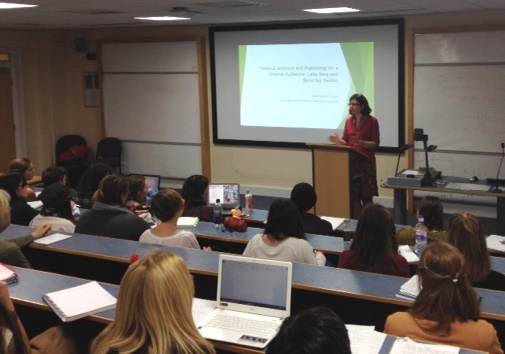Our archives had a lot of attention during Explore Archive Week, we think that its about time that we talked about books.
Anne Sharp writes about her visit to Seven Stories
Collection Store, along with 8 other North East based Library staff, as part of
an event organised by CILIP NE (The Chartered Institute of Library and
Information Professionals).
A visit to Seven Stories, National Centre for Children’s
Books had been on my wish list for some time, so I wasted no time in responding
to an invitation to do so, sent out through the CILIP NE network. The visit was not to the wonderful visitor
centre on the Ouseburn in Newcastle, but to the less visible, but equally
wonderful Seven Stories Collection Store, which is housed at Design Works
Business Centre, across the River Tyne, in Felling.
 |
| ©Damien Wootten for Seven Stories, The National Centre for Children's Books. |
Visiting a warehouse of books may not sound
particularly exciting however, Collections Officer, Paula Wride, who hosted the
visit, had taken great care to select and display items which represent the
range, scope and purpose of the book and archive collections. As well as books, she included examples of
hand-written notes and notebooks, typed manuscripts annotated with amendments (or
comments and doodles), story-boards, sketches, engravings and
water-colours. These demonstrated some
of the creative processes and stages, authors (including Enid Blyton,
David Almond, Philip Pullman, Martin Waddell, and Katherine Holabird), illustrators
(including Helen Craig, Faith Jaques, Polly Dunbar, Barbara Firth, Edward
Ardizzone, and John Lawrence) and publishers work through, and the challenges
of effectively conserving and storing different formats. Correspondence between authors and publishers
provided an insight into the formal nature of communications in the past, and
prompted discussion on the less formal and more ephemeral nature of
communication that email generates.
Although the collecting policy focuses on children’s
literature and illustration from 1930 onwards, earlier books are kept in the
context of specific archives donated to the collection, and include a copy of one
of the earliest children’s books, (Comenius’ Orbis Sensualism Pictus or Visible
World in pictures, written in Latin and English) in its 12th
edition published in 1777.
Great care is taken to conserve, store and catalogue each item in the collection, with formats ranging from handwritten notes to floppy-disk, and combine the expertise, perceptions and insights, of Librarian, Archivist, Conservator and Curator, to support in turn the Learning and Participation teams at the visitor centre, and the needs of researchers and schools. In addition to collections donated by specific authors, illustrators, or book collectors, several library collections have also been saved, preserving examples of works by less well-known authors and illustrators, book jackets, library bindings and practices. Among the book collections there are special collections of ABC books, paper engineered (Pop-up) books for children, counting and number books, a relatively small collection of factual books, and so on. In addition to being used in exhibitions and school visits (at the Visitor Centre), the book collections are used by researchers for a wide range of purposes – tracking the history of the book (paper, print, binding), book publishing, marketing, and specifically children’s books illustration; the works of a particular author or illustrator, period or genre; and even ballet and theatre companies for costume and set design.
 |
| ©Damien Wootten for Seven Stories, The National Centre for Children's Books. |
From my perspective, I studied Childhood and Children’s
Literature and Public Library Services to Children at Loughborough Library School,
and as a Children’s Librarian working in libraries and on mobile library
services, I witnessed the sheer joy that books bring to children – as pleasing
objects to handle, with pages to turn, lovely illustrations to draw you in and
stories to engage and absorb you. I’d
see their confidence grow week on week – confidence in choosing, handling,
reading and enjoying the journeys and worlds that books drew them into. Does
that still happen? I love the digital
world, but I still love books. Are
children still getting that opportunity and responding as they did before? Or differently?
A former Children’s Specialist in Public Libraries, Paula volunteered
many hours before landing a paid role at the Centre, and now coordinates the
work of a number of loyal volunteers (including ex-librarians) with the book
collections. She clearly cares about the
collection, her colleagues and the volunteers, the authors and illustrators,
and the needs of researchers and schools.
Her talk demonstrated a clear passion and dedication to her role, and
was enlivened with anecdotes, which I would share with you here… but who am I
to spoil a good story, for you really should visit yourself: http://www.sevenstories.org.uk/collection
Thanks again to CILIP NE, and in particular to Jennie
Hillyard, Librarian at the North of England Institute of Mining and Mechanical
Engineers, for organising an excellent visit.
Here’s a link to Jennie’s own blog post about the visit: https://mininglibrarian.wordpress.com/
- Anne Sharp
If you'd like to find out more about the Seven Stories Collection, then
email: collections@sevenstories.org.uk or leave a comment.










































